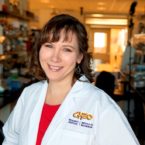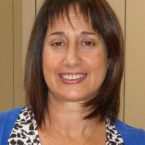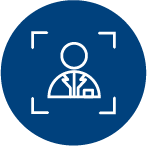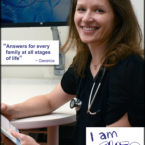Care4Rare is a nation-wide research program focusing on the improvement of both the diagnosis and treatment of rare diseases. Led out of the Children’s Hospital of Eastern Ontario (CHEO) Research Institute, CARE for RARE includes 21 academic sites across the country, and is recognized internationally as a pioneer in the field of genomics and personalized medicine.
Its team uses state of the art DNA sequencing technology to identify new rare disease genes for patients across Canada and around the world, and develops novel therapeutic approaches. Together, 80 physicians and 50 scientists work to advance rare disease research as part of the CARE for RARE program.
Currently, 25% rare disease patients wait 5-30 years for a diagnosis; 40% initially receive a misdiagnosis, and half will never receive a diagnosis. In contrast, the evidence-based approach being developed by CARE for RARE will result in an accurate rapid diagnosis for many affected by rare disease. Securing a clear diagnosis means that patients and families can make future projections about their healthcare, tap into best practice guidelines, seek reproductive counselling, and potentially start therapies.
In addition, only 5% of children with rare disease have access to an effective treatment. By investigating approved drugs for effectiveness in other diseases, CARE for RARE hopes to identify novel therapies for some of those currently without any treatment.
More information is also available at the Care4rare web page.
Related News
-
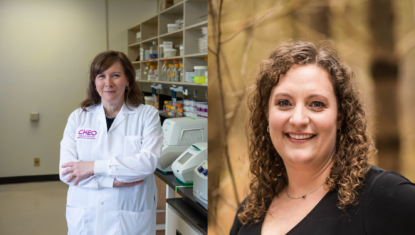
05/03/2025
CHEO Research Institute to help position Canada as global leader in precision health through genomic data generation
-
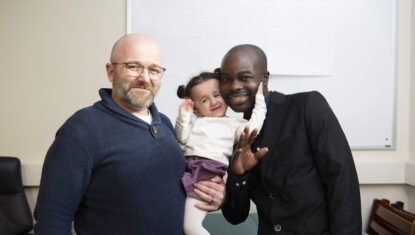
06/12/2024
CHEO Research Institute and Shriners Hospitals for Children Canada Collaborate to Launch First-of-its-kind Joint Pediatric Metabolic and Genetic Bone Disorders Fellowship
-
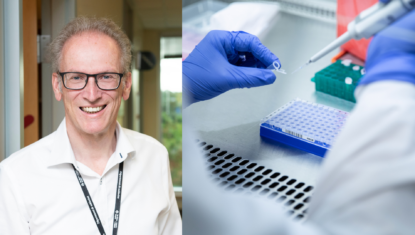
06/11/2024
New Genetic Discoveries Linked to Neurodevelopmental Diseases
Research Projects
-
Palovarotene in fibrodysplasia ossificans progressiva: review and perspective
23/01/2025
Palovarotene is a retinoic acid receptor gamma (RAR-γ) agonist that was originally designed for treatment of chronic obstructive pulmonary disease (COPD) by Roche Pharmaceuticals [Citation1]. Although it did not demonstrate a significant benefit in individuals with advanced COPD, preclinical studies in FOP mouse models suggested that drug repurposing could potentially be useful for the treatment of fibrodysplasia ossificans progressiva (FOP) [Citation2–4]. Phase-2 and -3 clinical trials on palovarotene, as well as a parallel natural history study (NHS), were the first worldwide clinical studies to be conducted and completed in patients with FOP [Citation5–7]. After this promising start the regulatory review process was complicated by several hurdles, but as of this writing, palovarotene is approved for use in preventing new heterotopic bone formation in FOP in the U.S.A., Canada, and Australia, but not in Europe. In this article, we summarize the history of palovarotene, the preclinical and clinical studies, the regulatory processes, and clinical recommendations from experts in FOP clinical care.
-
Evaluation of the diagnostic accuracy of exome sequencing and its impact on diagnostic thinking for patients with rare disease in a publicly funded health care system: A prospective cohort study
26/02/2024
The introduction of genomic technologies, such as exome sequencing (ES), has created an opportunity to shorten the uncertain and emotionally taxing “diagnostic odyssey” experienced by families with suspected rare genetic diseases (RGDs).1, 2, 3 A meta-analysis has demonstrated a diagnostic yield of 36% for both clinical and research-based ES in the context of a broad range of RGD indications.4 However, studies have typically been retrospective analyses on convenience samples of patients or large cohorts with unspecified phenotypes reported by diagnostic laboratories. Despite few randomized-controlled trials, systematic reviews, and health technology assessments, health care systems in various jurisdictions have moved to implement ES as a clinical test.5 How jurisdictions optimize this test’s implementation will depend on their health care system and context. However, sharing empirical evidence of the utility of this test and policy processes that support its use can guide health care systems in these implementation efforts.6
-
Burosumab for the treatment of cutaneous-skeletal hypophosphatemia syndrome
11/11/2023
Cutaneous-skeletal hypophosphatemia syndrome (CSHS) is a rare bone disorder featuring skeletal and skin manifestations, caused by mosaic somatic activating RAS family pathogenic variants with mosaic effects (Lim et al., 2016). CSHS is characterized by the overproduction of fibroblast growth factor-23 (FGF23), which is secreted by osteocytes in affected dysplastic bones (Ovejero et al., 2023). FGF23 causes inhibition of renal absorption and gastrointestinal absorption of phosphate by lowering sodium phosphate cotransporter activity and limiting 1,25-dihydroxyvitamin D (1,25(OH)2D) synthesis (Lim et al., 2016). Together, these biochemical aberrations result in hypophosphatemia, causing bone pain, rickets, long bone deformity, as well as impaired growth and mobility (Ovejero et al., 2016; Lim et al., 2016). Conventional treatment of CSHS with phosphate supplementation and active vitamin D does not directly address the FGF23 over-expression (Lim et al., 2014). While phosphate supplementation brings about temporary increases in serum phosphorus levels, it also increases FGF23 production, which ultimately perpetuates the renal phosphate-wasting and fails to successfully treat rickets. Burosumab is a fully human monoclonal antibody, given subcutaneously every two weeks in children, that neutralizes FGF23. Burosumab was recently shown to be superior to conventional therapy in a phase 3 randomized controlled trial in children with X-linked hypophosphatemia (XLH), another childhood-onset condition linked to FGF23 overproduction (Imel et al., 2019).
-
Exome and genome sequencing for rare genetic disease diagnosis: A scoping review and critical appraisal of clinical guidance documents produced by genetics professional organizations
01/11/2023
Over the past 12 years, exome sequencing and genome sequencing (ES/GS) technologies have transitioned from a research method used to identify new etiologies of rare genetic diseases (RGDs)1 to an implemented diagnostic test available to millions of patients with suspected RGDs and more common disorders through health care systems around the world (Birney E, Vamathevan J, Goodhand P. Genomics in healthcare: GA4GH looks to 2022. bioRxiv. 2017. https://doi.org/10.1101/203554). These technologies have produced a paradigm shift in the field of medical genetics, ushering in an era of genomic discovery and providing an opportunity to shorten long diagnostic odysseys in the clinic.2,3 This rapid pace of translation from research to clinical practice is unique among applications of genomic technologies related to precision medicine4 and has resulted in a significant challenge for health care system decision makers, including clinicians and payers, responsible for developing optimal, evidence-based clinical approaches using ES/GS testing in the context of a naive and rapidly evolving evidence base. Genetics health care professionals, including medical geneticists, laboratory geneticists, and genetic counselors, have been at the forefront of this challenge, tasked with identifying which families might benefit from ES/GS, running these tests, deciding what might be reported back to families (including findings unrelated to the primary indication for testing, hereon referred to as additional findings), and contextualizing these results. To support responsible and consistent practice among health care professionals within their membership, several organizations have generated guidance documents regarding the clinical implementation of ES/GS.
-
Medial Discoid Meniscus in Children: A Multicenter Case Series of Clinical Features and Operative Results
06/03/2023
Patient presentations and treatments for those with discoid medial menisci were similar to those reported for patients with discoid lateral menisci. Knees with discoid medial menisci also demonstrated instability attributed to peripheral insufficiency and posterior tears. Tears were present in over half of knees with discoid medial menisci, and reoperation was more common in knees that underwent repair of tears than those without repair.
-
Mitigating the Denosumab‑Induced Rebound Phenomenon with Alternating Short‑ and Long‑Acting Anti‑resorptive Therapy in a Young Boy with Severe OI Type V
03/03/2023
-
Bridging clinical care and research in Ontario, Canada: Maximizing diagnoses from reanalysis of clinical exome sequencing data
01/03/2023
-
Findings in percutaneous trans-hepatic cholecysto-cholangiography in neonates and infants presenting with conjugated hyperbilirubinemia: emphasis on differential diagnosis and cholangiographic patterns
14/01/2023
PTCC is a minimally invasive study in the diagnostic work-up of infants presenting with conjugated hyperbilirubinemia (suspected BA). Further invasive investigations or surgery can be avoided when results are normal.
-
Vamorolone versus placebo and prednisone in Duchenne muscular dystrophy: A randomized clinical trial
01/10/2022
Duchenne muscular dystrophy (DMD) is an X-linked recessive neuromuscular disorder affecting 1 in 3600 to 9300 male newborns.1 Treatment with oral corticosteroids (prednisone, deflazacort) delays loss of ambulation,2 but long-term corticosteroid treatment causes weight gain, stunting of growth, osteoporosis, mood disturbances, adrenal insufficiency, and other safety concerns leading to poor adherence to practice guidelines.3,4
-
Sickle Cell Bone Disease and Response to Intravenous Bisphosphonates in Children
16/05/2022
Our findings demonstrate that a wide range of SCD bone morbidity can present in childhood, and we report successful pain management with IV bisphosphonate therapy.
-
Impact of Burosumab Compared with Conventional Therapy in Younger Versus Older Children with X-Linked Hypophosphatemia
09/05/2022
In this post hoc subgroup analysis using data from the phase 3 study of burosumab vs Pi/D in children with XLH aged 1 to 12 years (9), we explored the effect of burosumab vs Pi/D on phosphate homeostasis, growth, lower limb deformity, and safety outcomes for those younger (aged 1-< 5 years) vs older (aged 5-12 years) at study onset.
-
Preventing symptomatic vitamin D deficiency and rickets among Indigenous infants and children in Canada
01/05/2022
-
Efficacy and safety of vamorolone in Duchenne muscular dystrophy: A 30-month non-randomized open-label extension study
25/01/2022
We found that vamorolone, a novel dissociative steroidal anti-inflammatory drug, was not associated with a change in TTSTAND velocity from baseline to 30 months among boys with DMD aged 4 to 7 at enrollment.
-
Dominant osteogenesis imperfecta with low bone turnover caused by a heterozygous SP7 variant
07/01/2022
-
Outcome of over 1500 matches through the Matchmaker Exchange for rare disease gene discovery: The 2-year experience of Care4Rare Canada
01/01/2022
Matchmaking through the MME is an effective way to investigate novel candidate genes; however, it is a labor-intensive process. Engagement from the community to contribute phenotypic, genotypic, and inheritance data will ensure that matchmaking continues to be a useful approach in the future.
-
Musculoskeletal features in adults with X-linked hypophosphatemia: An analysis of clinical trial and survey data
12/10/2021
The findings from this study highlight the frequency of clinically important musculoskeletal features in adults with XLH and their early onset, illustrating a scenario of premature musculoskeletal morbidity compared with the general population.
-
Insights into the expanding phenotypic spectrum of inherited disorders of biogenic amines
20/09/2021
Between January 1st 2015 and May 15th 2020, 429 patients were enrolled in the iNTD patient registry. Of these entries, 350 patients had a diagnosis of biogenic amine disorders. 75 patients who were transferred from the JAKE database on aromatic L-amino acid decarboxylase deficiency (http://www.biopku.org/home/jake.asp) were not analyzed in this study due to the high number of missing variables of interest. The remaining cohort of patients with disorders of biogenic amines consisted of 275 patients from 248 families (157 female (57%), from 42 countries: 196 patients born in Europe, 42 in North America, 34 in Asia, three in Central/South America and one in Africa). 109 patients had primary disorders of biogenic amine metabolism, 161 BH4 deficiencies (BH4Ds) and five patients DNAJC12D (Tables 2 and 3). All diagnoses were confirmed either by mutational analysis alone or by a combination of specific biochemical tests in CSF, urine and blood (Table 4).
-
Incidence and short-term outcomes of Kawasaki disease.
30/03/2021
KD incidence is increasing in Ontario, with greater healthcare utilization from hospitalizations and subsequent follow-up.
-
Patient-Reported Outcomes from a Randomized, Active-Controlled, Open-Label, Phase 3 Trial of Burosumab Versus Conventional Therapy in Children with X-Linked Hypophosphatemia
23/01/2021
In conclusion, changing to burosumab improved PRO measures, with statistically significant differences in PROMIS pain interference at week 40 versus continuing with conventional therapy and in PHS-10 at weeks 40 and 64 versus baseline.
-
Genetic and metabolic investigations for individuals with neurodevelopmental disorders: a survey of Canadian geneticists’ practices
01/01/2021
Evidence-based guidelines should be developed to facilitate best practices in Canada.
-
Assessment of longitudinal bone growth in osteogenesis imperfecta using metacarpophalangeal pattern profiles
27/07/2020
COL1A1 and COL1A2 mutations affect bone growth not only by inducing fractures and bone deformities, but also through longitudinal growth deficits in bones that do not fracture or deform.
-
Utility and practice of electrodiagnostic testing in the pediatric population: An AANEM consensus statement
02/11/2019
The panel found that electrodiagnostic studies continue to have high utility for the diagnosis of numerous childhood neuromuscular disorders, and that standardized approaches along with the use of high‐quality reference values are important to maximize the diagnostic yield of these tests in infants, children, and adolescents.
-
ALU transposition induces familial hypertrophic cardiomyopathy
01/09/2019
Our results demonstrate that haploinsufficiency resulting from MYBPC3 complete deletion, potentially mediated by Alu recombination, is an important disease mechanism in cardiomyopathy and emphasizes the importance of copy number variation analysis in patients clinically suspected of HCM.
-
Epilepsy genetics: Current knowledge, applications, and future directions
01/07/2018
Drug screening with in vitro and in vivo models of epilepsy can potentially facilitate new treatment strategies.
-
Benefits of early referral to pediatric palliative care for a child with a rare disease
01/06/2018
This case is described to provide a voice for families who are caring for a child with an undiagnosed or life-limiting illness and especially for the families who won’t consider PPC either out of fear or not knowing it exists.
-
Iron Overload In Transfusion-Dependent Survivors Of Hemoglobin Bart’s Hydrops Fetalis
03/05/2018
While homozygous α0-thalassemia is currently considered a rare disease, its prevalence is likely to rise given the high α0-thalassemia gene carrier rates in Southeast Asia coupled with recent advances in fetal medicine that is delivering improved access to intra-uterine transfusions.
-
Addressing Challenges in the Diagnosis and Treatment of Rare Genetic Diseases
01/03/2018
Here, we discuss the increasing opportunity for diagnosis and therapy of rare diseases and how to tackle the associated challenges.
-
International Cooperation to Enable the Diagnosis of All Rare Genetic Diseases
05/05/2017
Provision of a molecularly confirmed diagnosis in a timely manner for children and adults with rare genetic diseases shortens their "diagnostic odyssey," improves disease management, and fosters genetic counseling with respect to recurrence risks while assuring reproductive choices.
-
Utility of whole‐exome sequencing for those near the end of the diagnostic odyssey: time to address gaps in care
01/03/2016
In the next decade we will witness a paradigm shift in the way we care for patients with rare genetic diseases, addressing a significant gap in the management of individuals with rare diseases. The diagnostic journey for patients will include clinical genomic sequencing, which in the not too distant future will be WGS as costs decrease with new platforms. The accessibility of WGS‐based diagnostics for patients will be central to understanding the complete compendium of human genetic pathology. Strategies and infrastructure should be put in place to facilitate discovery in clinical settings, and to further mine large phenotypic and genomic datasets for disease mechanisms. As we understand the etiology of more rare diseases, it is probable that we will increasingly implicate known genes and that the approach to the completion of the complete Mendelian dataset will be asymptotic. There will be a subset of rare diseases that are due to non‐coding mutations in regulatory regions that may be more readily identified with the imminent use of WGS and RNA sequencing, and to implicate and understand this type of variation will require large‐scale data sharing at an impressive level. Ultimately, such datasets will be instrumental in identifying modifiers of disease, providing insight into phenotypic variability, prognosis, and for a subset of diseases, identifying drug targets. Finally, NGS technologies are providing significant opportunities to implement personalized health strategies including prevention or early detection of disease, improved health maintenance, and development of tailored therapy for patients with rare genetic diseases.
-
Biallelic Mutations in BRCA1 Cause a New Fanconi Anemia Subtype
01/08/2015
The proband presented at birth with microsomia and dysmorphic features (Fig. 1A). Growth parameters were less than the 0.4 percentile at term (birth weight 1990g, height 40.5 cm, head circumference (HC) 27 cm), and subsequent catch-up growth was not evident at 25 years of age (weight 40 kg, −3.03 S.D.; 135 cm tall, −4.35 S.D.; HC 48.5 cm, approx.−4 to −5 S.D.). Additional congenital abnormalities included sparse hair, upslanted palpebral fissures, blepharophimosis, a narrow palate, dental malocclusion, a high-pitched and hoarse voice, hyper and hypopigmented skin lesions, duodenal stenosis and a slightly enlarged left kidney. She has proximally inserted thumbs (Fig. 1A), 2nd digit camptodactyly, 2–3 toe syndactyly and hyperextensible knees as well as a history of hip dislocation. Conductive hearing loss was diagnosed at 4 years of age. Bone age at 2y 3m was delayed (1y and 6m (−2S.D.)), but had normalized by 9 years. The patient also has mild intellectual disability with significantly delayed speech. At 23 years of age she was diagnosed with ductal breast carcinoma that was estrogen and progesterone receptor positive and Her2 negative. Mastectomy was performed followed by treatment with docetaxel, fluorouracil-epirubicin-cyclophosphamide and radiation therapy. A prophylactic mastectomy was performed on the contralateral breast at age 25. The patient did not experience unusual treatment associated toxicity and has not been diagnosed with bone marrow failure to date.
-
Evidence for Clinical, Genetic and Biochemical Variability in Spinal Muscular Atrophy With Progressive Myoclonic Epilepsy
01/12/2014
The results of the WES and the functional studies prompted an electromyography (EMG) study that showed evidence of motor neuron disease despite only mild proximal muscle weakness.
-
Mutations in PIK3R1 Cause SHORT Syndrome
06/06/2013
Our findings show that PIK3R1 mutations are the major cause of SHORT syndrome and suggest that the molecular mechanism of disease might involve downregulation of the PI3K-AKT-mTOR pathway.
-
Targeted therapies for congenital myasthenic syndromes: systematic review and steps towards a treatabolome
We assess the strength and quality of the evidence and create a dataset that provides the foundation for a computer-aided system to enable clinicians to gain easier access to information about treatable variants and the evidence they need to consider.
Researchers
-
Kym M Boycott
Senior Scientist, CHEO Research Institute
-
Sasha Carsen
Scientist, CHEO Research Institute
-
David A. Dyment
Scientist, CHEO Research Institute
-
Helly Goez
Investigator, CHEO Research Institute
-
Taila Hartley
Investigator, CHEO Research Institute
-
Olga Jarinova
Investigator, CHEO Research Institute
-
Eric LaCasse
Associate Scientist, CHEO Research Institute
-
Hanns Lochmüller
Senior Scientist, CHEO Research Institute
-
Private: Jean McGowan-Jordan
Investigator, CHEO Research Institute
-
Hugh McMillan
Investigator, CHEO Research Institute
-
Izabella Pena
Scientist, CHEO Research Institute
-
Marie-Eve Robinson
Investigator, CHEO Research Institute
-
Sarah Sawyer
Investigator, CHEO Research Institute
-
Christiaan Scott
Investigator, CHEO Research Institute
-
Kevin Smit
Investigator, CHEO Research Institute
-
Christina Vadeboncoeur
Investigator, CHEO Research Institute
-
Leanne Ward
Senior Scientist, CHEO Research Institute
-
Richard Webster
Investigator, CHEO Research Institute
-
Justyna Wolinska
Investigator, CHEO Research Institute

